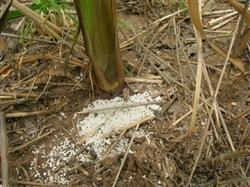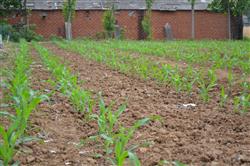How to fertilize summer corn?

How does summer corn top dressing? Please give me an introduction Most summer corn uses no-tillage method, generally not much basal fertilizer, interplanting summer corn, seed fertilizer is rarely applied. Therefore, the nutrients needed for the growth and development of summer maize are mainly met by topdressing, so topdressing plays a key role in high yield of summer maize. In topdressing, fertilization in the following periods should be emphasized to achieve high quality and high yield of maize and improve economic benefits. Seedling fertilizer is a fertilizer applied once after corn seedling setting. Seedling fertilizer should be applied early (3~4 leaves) and partially (young seedlings and weak seedlings). After the 3 leaves of corn are unfolded, the nutrients in the seed endosperm have been exhausted, and the root system begins to absorb nutrients from the soil. At this time, the nutritional organs of corn have grown vigorously. If the soil lacks nutrients, it will seriously affect the growth and development of corn. Timely topdressing is conducive to the formation of strong seedlings and lays the foundation for high yield. The amount of fertilizer applied to seedlings can account for about 40% of the total amount of topdressing. If there is seed fertilizer when sowing, the amount of seedling fertilizer can be appropriately reduced and the fertilization time delayed. Generally, 500~750 kg of decomposed organic fertilizer, 3~4 kg of urea, or 7.5~10 kg of ammonium bicarbonate are applied per mu. Maize is sensitive to zinc. If zinc deficiency has a great effect on yield, it is appropriate to apply zinc sulfate 1~1.5 kg per mu in combination with seedling fertilizer. Jointing fertilizer should not only meet the needs of root, stem and leaf growth in large quantities, but also ensure the nutrient supply for reproductive organ development, so that vegetative growth and reproductive growth can be coordinated. Therefore, jointing fertilizer is usually applied before and after jointing of corn at 7~9 leaves. The fertilizer should be applied late or less for strong seedlings, early or heavy for thin seedlings, 15~20 kg ammonium bicarbonate per mu, and 600~750 kg human and livestock manure. It is beneficial to the development of strong roots, strong culms and more ears, large ears and more grains, and can prevent empty culms and lodging. When corn appears big bell mouth, it is already the vigorous development period of male and female flower organs of corn, which is the key period to determine the size of ear, the number of seeds and the strength of pollen vitality. If the fertilizer is deficient, it often leads to baldness and increased grain number, and the yield is seriously reduced. Therefore, the fertilizer can not be ignored. Generally, 500~600 kg of human and animal manure per mu, 7.5~10 kg of urea, 35 ~ 40 kg of 45% compound fertilizer, or 35~40 kg of 45% compound fertilizer are better. The specific fertilization time should be 10~15 days before tasseling, when the tassels can be touched by hand, the weak seedlings can be advanced appropriately, and the vigorous seedlings can be delayed slightly. The ear fertilizer generally accounts for about 40% of the fertilizer amount. Supplementary grain fertilizer should be determined according to the growth of corn. When the bud fertilizer is insufficient, there are many yellow leaves below the ear node, and the phenomenon of de-fertilization occurs, grain fertilizer should be applied; otherwise, the vigorous growth cannot be applied. Grain fertilizer is generally applied when corn ears are silking, 2~3 kg urea per mu, and water is poured. It can also be used as topdressing with 25~30 kg ammonium bicarbonate per mu when corn silk turns red after pollination, which can promote grain filling and increase grain weight. Grain fertilizer generally accounts for about 20% of fertilizer application. By spraying 0.2%~0.3% potassium dihydrogen phosphate 2~3 times at jointing stage, maize yield could be increased by about 10%. Spraying 0.1%~0.3% zinc sulfate solution at seedling stage and jointing stage could prevent maize white seedling mosaic disease. Summer corn topdressing nitrogen fertilizer application depth of about 10 cm is appropriate, after application of soil to prevent volatilization, seedling fertilizer from the plant 10~12 cm, ear fertilizer, grain fertilizer from the plant 15~20 cm. Click for more corn growing technology Click for more food crop growing technology
- Prev

Why is summer corn yellow?
Why is summer corn yellow? Is there any remedy? Yellowing and dullness of corn leaves are caused by lack of nitrogen in corn and soil, or by pests and diseases. Corn leaves yellow for a long time, often cause reproductive growth ahead of time, too early heading, resulting in bald, corn plants produce "not yet...
- Next

What should be prevented from planting summer corn?
What should be prevented from planting summer corn? Please introduce the following points to prevent the planting of summer corn: first, the high-yield characteristics of summer maize at ear stage are stout stalks, short internodes, broad and thick leaves, strong leaves and well-developed green roots. If the leaves turn yellow at the panicle stage, it is necessary to prevent late de-fertilization and premature senescence. ...
Related
- The first cup of black tea in spring, the flavor and history of tea gardens in Kenya, Africa
- The computer can not only choose potatoes, but also grow tea rice. AI will grow winter oolong tea champion.
- It is not only the inflated tea bitten by insects, but also engraved with the four seasons tea in Beipu.
- The Oriental Beauty Tea Festival in Zhuxian County takes the stage at the weekend to experience the plus-size feast of oil tea.
- & quot; Oriental Beauty Tea & Exploration of Emei in Hsinchu, the hometown of quot;
- The new variety of strawberry "Tainong 1" dessert is the first choice with mellow aroma. Crimson gorgeous
- History of Tea in Taiwan: from Wild Inner Mountain to Export Tea Garden
- Two types of Taiwan Oriental Beauty Black Tea won the British three-Star Award for Childhood Tea Xiang Zhang Jiaqi changed from pilot to champion tea maker.
- Banana species and varieties: the planting history of Taiwan Xianren banana and dwarf banana is long, is banana disease resistant?
- Coffee planting Technology: Qianjie Coffee from Seedling to harvesting

